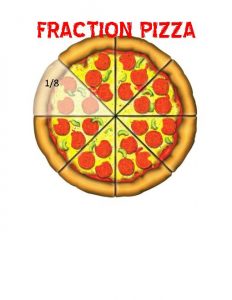 This is a fifth grade mathematics lesson integrated with technology. The focus of this lesson is adding fractions with unlike denominators. This activity would take place when students are beginning to understand how to add fractions with unlike denominators. The pizza problem is a classic example used when it comes to fractions, however this activity is going to have a little bit of a twist.
This is a fifth grade mathematics lesson integrated with technology. The focus of this lesson is adding fractions with unlike denominators. This activity would take place when students are beginning to understand how to add fractions with unlike denominators. The pizza problem is a classic example used when it comes to fractions, however this activity is going to have a little bit of a twist.
Normally, math is in the morning but for the day of this lesson, math will be moved to after lunch. During lunch students would be able to eat pizza that would be provided. After lunch, students will need to add up how many pieces of pizza are left, the top of the boxes will say how many slices each pizza was cut into. This should be fairly easy because the pizzas would most likely be cut into the same amount of pieces.
After the students have added up how much pizza is left, they will figure out how much pizza the class ate as a whole. Again, should be fairly simple for fifth grade students.
This is when the lesson will take advantage of the technology provided. You can either do this activity as a class or, depending on how many computers you have, you can have them work individually or in small groups.
On VisualFractions.com, there is an adding unlike fraction circles activity that students can do. The website will give the students the first addend and they will have to input the fraction that is shaded. Then, they will be provided with the second addend, again, having to provide a fraction for the shaded amount. Finally, they will have to add the two unlike fractions by finding equivalent fractions. If students get the answer wrong, it will tell them if the solution is greater than or less than the answer they gave.
Website: http://www.visualfractions.com/AddUnlikeCircle/
Education Technology EALR 1.1.2 Use models and simulations to explore systems, identify trends and forecast possibilities.
CCSS-Math 5.NF.1 Add and subtract fractions with unlike denominators (including mixed numbers) by replacing given fractions with equivalent fractions in such a way as to produce an equivalent sum or difference of fractions with like denominators.